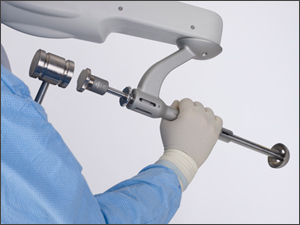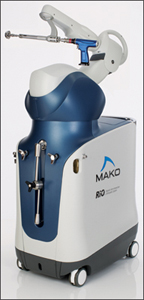Robotic Hip Surgery
MAKOplasty® Hip – General Copy Describing Procedure
 MAKOplasty® Hip is an innovative total hip replacement procedure that is performed using a highly advanced, surgeon-controlled robotic arm system. It can be a treatment option for people suffering with either non-inflammatory or inflammatory degenerative joint disease, and is designed to assist surgeons in attaining a new level of reproducible surgical precision in hip surgery.
MAKOplasty® Hip is an innovative total hip replacement procedure that is performed using a highly advanced, surgeon-controlled robotic arm system. It can be a treatment option for people suffering with either non-inflammatory or inflammatory degenerative joint disease, and is designed to assist surgeons in attaining a new level of reproducible surgical precision in hip surgery.
The hip is a ball-and-socket joint consisting of the spherical head of the femur, or thighbone, which moves inside a cup-shaped hollow socket in the pelvis called the acetabulum. When cartilage in the hip wears down, bare bone is exposed. When bone-on-bone contact occurs within the joint it causes pain that can be felt in the groin, outside the hip, at the base of the spine, or radiating from the thigh to the knee. Hip implants reconstruct a bearing surface to replace lost cartilage and prevent painful bone-on-bone wear. Total hip replacement consists of removing diseased bone in the acetabulum, which is fit with a cup and liner, and replacing the femoral head with new head and stem components.
 The goal of using robotic arm technology to perform hip replacement is to attain consistent precision in surgery. Accurate placement and alignment of implant components are a critical factor in hip replacement.
The goal of using robotic arm technology to perform hip replacement is to attain consistent precision in surgery. Accurate placement and alignment of implant components are a critical factor in hip replacement.
MAKOplasty Hip helps the surgeon place the implants in the desired location, providing a good, stable biomechanical reconstruction and acceptable leg length restoration. It is performed with the RIO® Robotic Arm Interactive Orthopedic System. RIO enables surgeons to use a 3-D anatomic reconstruction based on a CT scan of the patient’s own hip to pre-surgically plan implant positioning. During the procedure, it provides real-time data for intra-operative adjustments to further enable surgeons to optimally align and position implants, and accurately reproduce the surgical plan.
The operation is performed by preparing the femur first. The surgeon removes the amount of bone required for the implant, and the femoral component’s position is measured by RIO. Next the surgeon uses the robotic arm to accurately ream and shape the acetabulum to prepare it for cup placement. The RIO enables accuracy in controlling the depth of bone removal and determining the hip’s center of rotation which aides in implant positioning and alignment.
When the bone preparation is complete, the surgeon uses the robotic arm to implant the cup, and the plastic liner is locked into the metal cup. The femoral stem is implanted and the correct ball size is attached to the stem to reconstruct leg length and soft tissue tension.
As a total hip arthroplasty procedure, MAKOplasty® is typically covered by Medicare.
Related Brochures
![]() You will need the Adobe Reader to view and print these documents.Get Adobe Reader.
You will need the Adobe Reader to view and print these documents.Get Adobe Reader.
